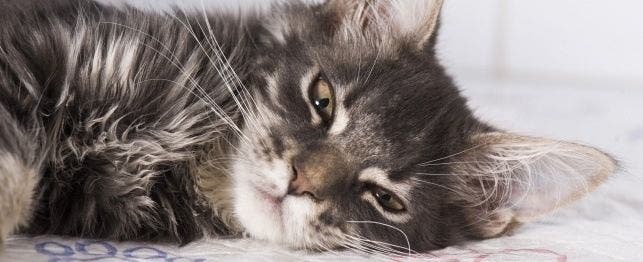
Does Your Cat Have the Sniffles?
Your cat is suddenly sneezing frequently, and her breathing sounds congested. When you pay closer attention, you notice she has a runny nose and watery eyes. She no longer comes running when she hears the sound of a can opening, and she’s sleeping a lot – even for a cat. Your kitty may have a common problem – an upper respiratory infection.
Feline upper respiratory infection refers to infections in the area of the nose, throat and sinus area, much like the common cold in humans. In cats, these infections are quite common and very contagious. The two primary viruses involved are feline herpesvirus-1 and feline calicivirus. Feline chlamydia, a bacterial infection, can also result in upper respiratory tract infections. Cats at most risk include young kittens, unvaccinated cats, elderly cats and cats that are kept in close quarters with other cats such as shelters, catteries and even multi-cat households.
Cats that recover from feline upper respiratory infection will periodically shed the virus throughout their lives in times of stress. It is uncommon for the cat to have a recurrence of the upper respiratory infection but they are considered a reservoir for the virus. These viruses do not live long in the environment and are easily killed by household cleaners, such as bleach. Unfortunately, unsuspecting owners can carry the virus from an ill or viral-shedding cat to their homes. This is a common way that feline upper respiratory infections are transmitted.
What To Watch For
Cats susceptible to upper respiratory infections generally develop sneezing, watery eyes and nasal discharge about 2 to 5 days after exposure. Fever and sinus congestion may also occur. The disease typically resolves in 10 to 14 days, without complications. Be on the alert for complications such as lack of appetite due to poor smelling ability, pneumonia, eye ulcers or mouth sores. Very young kittens have a higher incidence of pneumonia and some do not survive the infection.
Diagnosis
Diagnosing feline upper respiratory infection is generally based on physical exam findings and typical symptoms of fever, congestion, sneezing, watery eyes, nasal discharge and occasionally drooling. Finding the exact viral or bacterial cause of the infection, however, is more difficult, and your veterinarian may not want to pursue it. Some diagnostic tests might prove helpful, such as nasal or throat swabs, blood tests to determine the overall health of the cat, and chest x-rays to detect pneumonia.
Treatment
Since most upper respiratory infections are viral, there are no drugs available to kill these viruses. Treatment is aimed at alleviating the symptoms and maintaining your cat’s overall health to bolster the immune system and help speed recovery. Basic treatment usually includes proper diet and sufficient fluids, antibiotics, nebulization (a process to humidify the air and keep the nasal passages moist), and eye medication if eye ulcers are present. If your cat does not respond to treatment at home, hospitalization may be necessary.
Home Care
If your cat is treated at home you will need to provide care that includes:
- Keeping the nose and eyes clear of discharge
- Administering all medications your veterinarian prescribes
- Providing sufficient food and fluids so your cat does not become dehydrated
- Keeping your cat away from other cats
Preventative Care
The best way to prevent upper respiratory infections is to follow the vaccination procedures by your veterinarian. Vaccines can be administered by two methods, intranasal method and injection. Also, keep your cat away from other sneezing, ill cats and take precautions when introducing a new cat to the household.